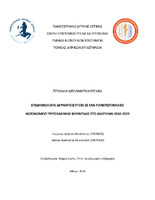| dc.contributor.advisor | Siopi, Maria | |
| dc.contributor.author | Καντιδενού, Μαρία - Αναστασία | |
| dc.contributor.author | Βιταλιώτης, Γεώργιος - Χρήστος | |
| dc.date.accessioned | 2024-10-14T07:08:35Z | |
| dc.date.available | 2024-10-14T07:08:35Z | |
| dc.date.issued | 2024-10 | |
| dc.identifier.uri | https://polynoe.lib.uniwa.gr/xmlui/handle/11400/7700 | |
| dc.identifier.uri | http://dx.doi.org/10.26265/polynoe-7532 | |
| dc.description.abstract | Οι δερματοφυτίες συνιστούν τις πιο συχνά απαντώμενες μυκητικές λοιμώξεις. Ένα ιδιαίτερα ανησυχητικό φαινόμενο είναι αυτό της αναδυόμενης αντοχής των παθογόνων, κυρίως των Trichophyton spp., στις θεραπείες εκλογής. Επί του παρόντος, οι πληροφορίες σχετικά με τη σύγχρονη επιδημιολογία των δερματοφυτιών στην Ελλάδα είναι περιορισμένες. Ως εκ τούτου, πραγματοποιήθηκε ανασκόπηση της βιβλιογραφίας, με σκοπό τη σκιαγράφηση της τοπικής επιδημιολογίας, και διενεργήθηκε αναδρομική μελέτη περιγράφοντας την επιδημιολογία των δερματοφυτιών σε ένα Πανεπιστημιακό νοσοκομείο τα τελευταία έτη. Καταγράφηκαν τα μικροβιολογικά τεκμηριωμένα περιστατικά δερματοφυτίας σε άτομα με κλινική υποψία της νόσου που επισκέφτηκαν το Π.Γ.Ν. «Αττικόν» κατά την τριετία 2020-2022. Τα απομονωθέντα στελέχη ταυτοποιήθηκαν μοριακά (PCR-RFLP και αλληλούχιση της περιοχής ITS1-5.8S-ITS2) και πραγματοποιήθηκε έλεγχος ευαισθησίας τους στην τερμπιναφίνη, στην ιτρακοναζόλη και στη βορικοναζόλη με την πρότυπη μεθοδολογία EUCAST E.Def 11.0. Η συχνότητα εμφάνισης της λοίμωξης, καθώς και η κατανομή των δερματοφύτων και το προφίλ της in vitro ευαισθησίας τους στα αντιμυκητικά συγκρίθηκαν με τα αντίστοιχα δεδομένα για το διάστημα 2010-2019.
Στο διάστημα 2020-2022, η μέση (εύρος) συχνότητα εμφάνισης της δερματοφυτίας ήταν 18% (15%-23%), ενώ δεν παρατηρήθηκε σημαντική αύξηση των επεισοδίων στο βάθος της 13ετίας 2010-2022 (p = 0.08). Ο επικρατέστερος αιτιολογικός παράγοντας της λοίμωξης ήταν το T. rubrum (33%), ακολουθούμενο από M. canis (19%), T. indotineae (18%), T. tonsurans (10%), T. interdigitale (9%), T. mentagrophytes (5%) και άλλα είδη (5%). Συγκριτικά με τα έτη 2010-2019, σημειώθηκε σημαντική αύξηση του T. indotineae (p = 0,002) συνοδευόμενη από παράλληλη μείωση του T. rubrum (p = 0,02). Όλα τα στελέχη ταξινομήθηκαν ως άγριου τύπου στις αζόλες, ενώ φαινότυπος μη-άγριου τύπου στην τερμπιναφίνη εντοπίστηκε μόνο για το σύνολο των στελεχών T. indotineae. Ο αριθμός των ανθεκτικών στην τερμπιναφίνη δερματοφυτιών οφειλόμενων σε Trichophyton spp. αυξήθηκε σημαντικά σε σύγκριση με την περίοδο 2010-2019 (p = 0,002).
Τα επιδημιολογικά δεδομένα για τις δερματοφυτίες στην Ελλάδα είναι περιορισμένα και αναχρονιστικά. Η σημαντική αύξηση στη συχνότητα απομόνωσης T. indotineae υποδεικνύει ότι η περιοδική επανεξέταση της κατανομής των ειδών είναι κρίσιμη για τη σωστή διαχείριση της λοίμωξης. Η αντοχή στην τερμπιναφίνη αποτελεί αναδυόμενο πρόβλημα στην Ελλάδα. Το εύρημα αυτό πρέπει να σημάνει συναγερμό για τον έλεγχο της in vitro ευαισθησίας στα αντιμυκητικά σε τοπική κλίμακα, ιδίως σε περιπτώσεις ασθενών που δεν ανταποκρίνονται στη θεραπεία. | el |
| dc.format.extent | 102 | el |
| dc.language.iso | el | el |
| dc.publisher | Πανεπιστήμιο Δυτικής Αττικής | el |
| dc.rights | Αναφορά Δημιουργού - Μη Εμπορική Χρήση - Παρόμοια Διανομή 4.0 Διεθνές | * |
| dc.rights | Attribution-NonCommercial-NoDerivatives 4.0 Διεθνές | * |
| dc.rights.uri | http://creativecommons.org/licenses/by-nc-nd/4.0/ | * |
| dc.subject | Δερματοφυτία | el |
| dc.subject | Trichophyton indotineae | el |
| dc.subject | Αντοχή στην τερμπιναφίνη | el |
| dc.subject | Ελλάδα | el |
| dc.subject | Επιδημιολογία | el |
| dc.title | Επιδημιολογία δερματοφυτιών σε ένα Πανεπιστημιακό νοσοκομείο τριτοβάθμιας φροντίδας, στο διάστημα 2010 - 2022 | el |
| dc.title.alternative | Epidemiology of dermatophytoses in a University tertiary care hospital during 2010 – 2022 | el |
| dc.type | Πτυχιακή εργασία | el |
| dc.contributor.committee | Βογιατζάκη, Χρυσάνθη | |
| dc.contributor.committee | Beloukas, Apostolos | |
| dc.contributor.committee | Siopi, Maria | |
| dc.contributor.faculty | Σχολή Επιστημών Υγείας & Πρόνοιας | el |
| dc.contributor.department | Τμήμα Βιοϊατρικών Επιστημών | el |
| dc.description.abstracttranslated | Dermatophytoses are the most commonly encountered fungal infections. A particularly worrying phenomenon is the emergence of resistant pathogens, especially Trichophyton spp., to first-line antifungal treatments. Currently, data on the contemporary epidemiology of dermatophytosis in Greece are limited. Therefore, a review of the literature was performed to provide an overview of the local epidemiological situation, and a retrospective study was conducted describing the epidemiology of dermatophytoses in a University hospital over the past years.
All microbiologically confirmed cases in individuals with clinically suspected dermatophytosis attending “Attikon” hospital during 2020-2022 were recorded. The recovered isolates were molecularly identified (PCR-RFLP and sequencing of the ITS1-5.8S-ITS2 region) and their in vitro susceptibility to terbinafine, itraconazole and voriconazole was assessed using the EUCAST E.Def 11.0 reference methodology. The incidence of infection, as well as the species distribution and antifungal resistance were compared to the corresponding data of the period 2010-2019.
During 2020-2022, the mean (range) incidence of dermatophytosis was 18% (15%-23%), while no significant increase was observed over the 13-year period 2010-2022 (p = 0,08). The predominant causative agent of the infection was T. rubrum (33%), followed by M. canis (19%), T. indotineae (18%), T. tonsurans (10%), T. interdigitale (9%), T. mentagrophytes (5%) and other species (5%). Compared to the years 2010-2019, there was a significant increase in T. indotineae (p = 0,002) accompanied by a parallel decrease in T. rubrum (p = 0,02). All isolates were classified as wild-type to azoles, while a non-wild-type phenotype to terbinafine was detected only among all T. indotineae strains. The number of terbinafine-resistant Trichophyton dermatophytoses increased significantly compared to 2010-2019 (p = 0,002).
Epidemiological data on dermatophytoses in Greece are limited and out-of-date. The significant increase in T. indotineae isolation frequency suggests that periodic review of species distribution is critical for proper management of the infection. Terbinafine resistance is an emerging problem in Greece. This finding must prompt for antifungal susceptibility testing on a local scale, particularly in non-responding cases. | el |


